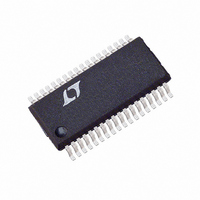LTC3731HG#PBF Linear Technology, LTC3731HG#PBF Datasheet - Page 12

LTC3731HG#PBF
Manufacturer Part Number
LTC3731HG#PBF
Description
IC SW REG CTRLR SYNC BUCK 36SSOP
Manufacturer
Linear Technology
Series
PolyPhase®r
Type
Step-Down (Buck)r
Datasheet
1.LTC3731HG.pdf
(34 pages)
Specifications of LTC3731HG#PBF
Internal Switch(s)
No
Synchronous Rectifier
Yes
Number Of Outputs
1
Voltage - Output
0.6 ~ 6 V
Frequency - Switching
225kHz ~ 680kHz
Voltage - Input
4 ~ 36 V
Operating Temperature
-40°C ~ 140°C
Mounting Type
Surface Mount
Package / Case
36-SSOP
Primary Input Voltage
7V
No. Of Outputs
1
Output Voltage
32V
Output Current
5A
No. Of Pins
36
Operating Temperature Range
0°C To +70°C
Msl
MSL 1 - Unlimited
Rohs Compliant
Yes
Lead Free Status / RoHS Status
Lead free / RoHS Compliant
Current - Output
-
Power - Output
-
Available stocks
Company
Part Number
Manufacturer
Quantity
Price
operaTion
LTC3731H
Input Undervoltage Reset
The RUN/SS capacitor will be reset if the input voltage
(V
capacitor on the RUN/SS pin will be discharged until
the short-circuit arming latch is disarmed. The RUN/SS
capacitor will attempt to cycle through a normal soft-start
applicaTions inForMaTion
The basic application circuit is shown in Figure 1 on the
first page of this data sheet. External component selection
is driven by the load requirement, and normally begins
with the selection of an inductance value based upon the
desired operating frequency, inductor current and output
voltage ripple requirements. Once the inductors and op-
erating frequency have been chosen, the current sensing
resistors can be calculated. Next, the power MOSFETs
and Schottky diodes are selected. Finally, C
are selected according to the voltage ripple require-
ments. The circuit shown in Figure 1 can be configured
for operation up to a MOSFET supply voltage of 28V
(limited by the external MOSFETs and possibly the mini-
mum on-time).
Operating Frequency
The IC uses a constant frequency, phase-lockable ar-
chitecture with the frequency determined by an internal
capacitor. This capacitor is charged by a fixed current plus
an additional current which is proportional to the voltage
applied to the PLLFLTR pin. Refer to the Phase-Locked
Loop and Frequency Synchronization section for additional
information.
A graph for the voltage applied to the PLLFLTR pin versus
frequency is given in Figure 3. As the operating frequency
is increased the gate charge losses will be higher, reducing
efficiency (see Efficiency Considerations). The maximum
switching frequency is approximately 680kHz.
Inductor Value Calculation and Output Ripple Current
The operating frequency and inductor selection are inter-
related in that higher operating frequencies allow the use
of smaller inductor and capacitor values. So why would
CC
) is allowed to fall below approximately 4V. The
(Refer to Functional Diagram)
IN
and C
OUT
ramp up after the V
prevents power supply latchoff in the event of input power
switching break-before-make situations. The PGOOD pin
is held low during start-up until the RUN/SS capacitor
rises above the short-circuit latchoff arming threshold of
approximately 3.8V.
anyone ever choose to operate at lower frequencies with
larger components? The answer is efficiency. A higher
frequency generally results in lower efficiency because
of MOSFET gate charge and transition losses. In addi-
tion to this basic tradeoff, the effect of inductor value on
ripple current and low current operation must also be
considered. The PolyPhase approach reduces both input
and output ripple currents while optimizing individual
output stages to run at a lower fundamental frequency,
enhancing efficiency.
The inductor value has a direct effect on ripple current.
The inductor ripple current ∆I
N, decreases with higher inductance or frequency and
increases with higher V
where f is the individual output stage operating
frequency.
∆I
L
=
V
Figure 3. Operating Frequency vs V
700
600
500
400
300
200
OUT
fL
0
1
−
0.5
CC
PLLFLTR PIN VOLTAGE (V)
V
V
OUT
IN
supply rises above 4V. This circuit
IN
1
or V
OUT
1.5
L
per individual section,
:
2
3731H F03
PLLFLTR
2.5
3731Hfb













